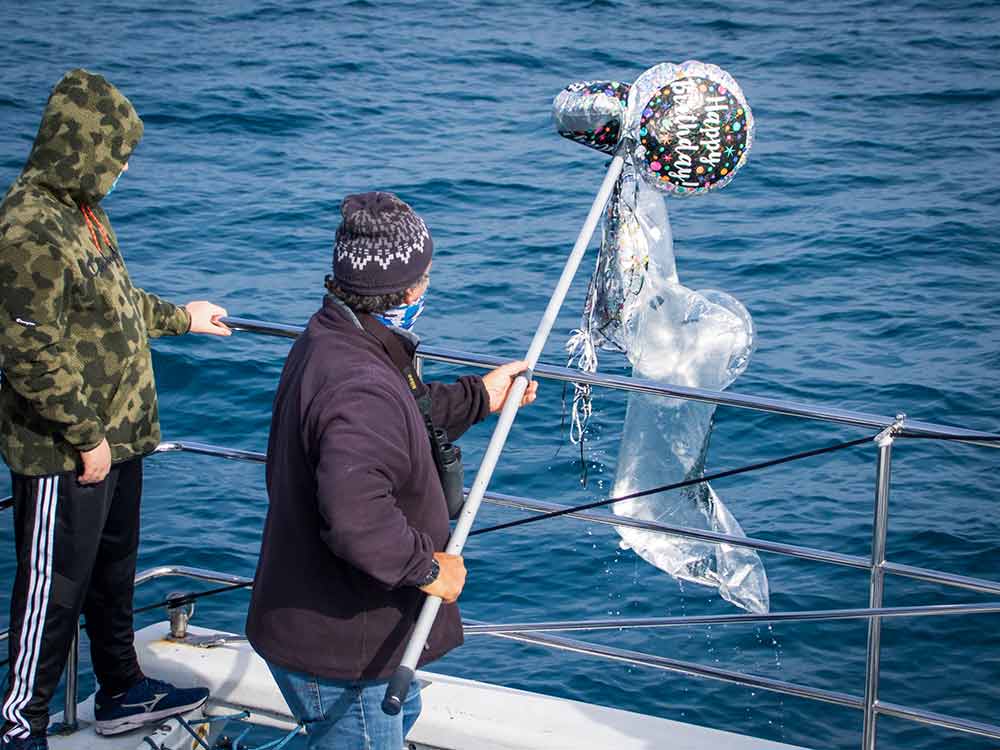Why Balloons Blow

Balloon safety is critical in keeping our oceans safe and clean for many sea birds, whales, dolphins, turtles, sea lions, seals, sharks, fish, and more! The simple act of watching a balloon float into the sky causes fatal harm to curious ocean animals living down below the ocean’s surface.
Nothing says “let’s celebrate” like a bouquet of bright and colorful balloons. They come in every color, shape, and size and have become the flagship of party décor. Releasing helium balloons and watching them gently float off into the sky for a special birthday, graduation, Valentine’s Day, New Year’s, or to commemorate a lost loved one may seem like the perfect way to honor or celebrate someone or something but it is festivities like these, without practicing balloon safety, that causes treacherous and sometimes deadly impact to swift swimmers lurking below the surface of the sea.
Nearly 45 to 50 million balloons are sold in California each year, and according to the Ocean Conservancy’s annual International Coastal Cleanup, nearly 300,000 balloons were found along the U.S. beaches. Many people do not realize the massive impact that follows when the simple act of letting go of balloons and the strings they trail behind can cause animals in the ocean.
In 2021, the California Coastal Cleanup Commission removed more than 300,000 pounds of trash (balloons included) from beaches and waterways. You’ve heard the age-old saying “what goes up must come down” right? When the party is over and your guests have all gone home, if balloon safety is overlooked when these mortality makers are released, the balloons are still up in the air, continuing their atmospheric dance to their eventual and inevitable ocean landing. This disastrous crescendo results in what researchers call marine debris.
“Marine debris is everywhere—it is found around every major body of water on the planet and along every shoreline in the world, no matter how remote. Marine debris is a global pollution problem that impacts human health and safety, endangers wildlife and aquatic habitats, and costs local and national economies millions in wasted resources and lost revenues.”- CA Coastal Commission
Our once pristine oceans have become cluttered with plastic nano and microparticles found in every ocean and sea in every part of the world. Soft plastics and fine metals, such as the materials used in latex and mylar balloons, rank up at the top when it comes to cause-of-death in seabirds. Balloon safety helps to prevent the deterioration of plastic (which is what balloons are made of) in our oceans too.
“…multiple research studies estimated between 15 to 51 trillion particles of floating microplastic (defined as smaller than 200 mm) are in the world’s oceans, weighing between 93 and 236 thousand metric tonnes… “ – CA Coastal Commission
Practicing balloon safety also means being mindful of the strings attached to balloons, which can be just as dangerous as the balloons themselves. As mylar balloons deteriorate, their color begins to fade, and these once colorful balloons ultimately become clear. Disguised as ocean jellyfish doppelgangers, luring the marine animals along their path as they deflate and fade out, the strings attached replicate the tendrils and can cause entanglements too.
Sea turtles and one of our favorite fish, the Mola mola (commonly called an ocean sunfish, the largest bony fish in the ocean), are among those regularly threatened by balloons due to the lack of human balloon safety. These gentle and curious fish commonly munch on jellyfish, which is one of their all-time favorite snacks on their daily menu.
For most marine animals, balloons can cause severe and often fatal problems with digestion. Balloons can present the animal with a false sense of feeling full or block airways resulting in suffocating these animals. The cetaceans you love to see out on our trips are mammals just like us. When mammals cannot reach the surface to breathe they can suffocate. Ingesting balloons also means becoming weak from lack of proper digestion and eventual mortality.
We as land mammals can help change this outcome by practicing balloon safety, disposing of balloons properly, and cutting off balloon strings instead of letting them go free to fly in the atmosphere until they hit the ocean’s surface.
Whale endangerment and entanglement sadly account for one of the biggest threats leading to the death or severe injury to our incredible cetaceans. While long line fishing nets and lines still take the top spot and are a significant contributor, balloons are still a silent but violent killer on the loose. Some states are beginning to take a stance on balloon releases. In a valiant effort to help protect their inherent wildlife, Hawaii recently passed a law making balloon release illegal.
Sometimes seeing is believing, and while California has not yet passed this same law, we at Captain Dave’s Dolphin and Whale Watching Safari do everything we can to keep our oceans clean. Showing passengers firsthand what marine debris looks like and what it can do to our amazing wildlife is an impactful way to learn more about balloon safety, and on some occasions, will shock you on just how much we see out there in one trip! So next time you are out on a trip with us, don’t be surprised if our captains slow down so crews can pull these floating death traps out of the water.

In 2021 the first-ever Whale Heritage Site in the Americas was named right here in Dana Point, California, because more whales and dolphins are swimming through our waters every day than anywhere else in the world. This is what makes Dana Point the #1 location for whale watching. Our oceans are meant for preserving and enjoying and we can’t wait to bring you on the water to see some of the spectacular animals we see every day! There is no better time than right now to book your trip out to sea! When you book a Dana Point whale watching safari, you will not only have the opportunity to relax and connect with nature in the warm California sun; you will also learn about eco-friendly alternatives to balloons and balloon safety from Capt. Dave’s amazingly knowledgeable captains, crews, and marine life specialists. If whales and dolphins are something you love to see in the sea, then practicing balloon safety at all of your future celebrations contributes to the continued success of our sea life to thrive.
Until then,
Jess Wright
First Mate and Marine Naturalist
Capt. Dave’s Dolphin & Whale Watching Safari
